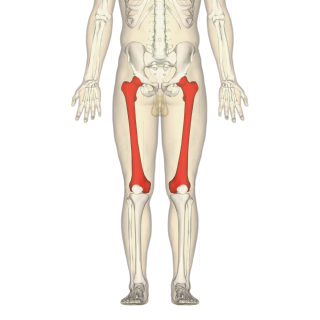
The femur or thigh bone, is the proximal bone of the hindlimb in tetrapod vertebrates. The head of the femur articulates with the acetabulum in the pelvic bone forming the hip joint, while the distal part of the femur articulates with the tibia and kneecap forming the knee joint. By most measures the femur is the strongest bone in the body. The femur is also the longest bone in the human body.

The jaw is any opposable articulated structure at the entrance of the mouth, typically used for grasping and manipulating food. The term jaws is also broadly applied to the whole of the structures constituting the vault of the mouth and serving to open and close it and is part of the body plan of most animals.
The quadratojugal is a cranial bone that is present in many tetrapods and their close relatives. It forms the rear lower corner of the skull, typically connecting to the jugal from the front and the squamosal from above. The inner face of the quadratojugal also connects to the quadrate bone which forms the cranium's contribution to the jaw joint. Many living and extinct reptiles and amphibians possess a quadratojugal, but the bone has been lost or fused to other bones in several lineages. Modern examples of tetrapods without a quadratojugal include salamanders, mammals, birds, and squamates.

The articular bone is part of the lower jaw of most vertebrates, including most jawed fish, amphibians, birds and various kinds of reptiles, as well as Stem-mammal. In these animals it is connected to two other lower jaw bones, the suprangular and the angular. It forms the jaw joint by articulating with the quadrate bone of the skull.

A snake skeleton consists primarily of the skull, vertebrae, and ribs, with only vestigial remnants of the limbs.

The upper extremity, proximal extremity or superior epiphysis of the femur is the part of the femur closest to the pelvic bone and the trunk. It contains the following structures:

The squamosal is a bone of the head of higher vertebrates. It is the principal component of the cheek region in the skull, lying below the temporal series and otic notch and bounded anteriorly by the postorbital. Posteriorly, the squamosal articulates with the posterior elements of the palatal complex, namely the quadrate and pterygoid. The squamosal is bordered anteroventrally by the jugal and ventrally by the quadratojugal.

The quadrate tubercle is a small tubercle found upon the upper part of the femur, that serves as a point of insertion of the quadratus femoris along with the intertrochanteric crest and the linea quadrata.
Judeasaurus is an extinct genus of small, aquatic varanoid lizard related to the mosasauroids. The only known specimen is from the Late Cretaceous of the Middle East, though its exact provenance is uncertain.
Jiangjunosaurus is a genus of herbivorous stegosaurian dinosaur from the Oxfordian-age Shishugou Formation of the Junggar Basin, Xinjiang, China.

The evolution of mammalian auditory ossicles was an evolutionary event in which bones in the jaw of reptiles were co-opted to form part of the hearing apparatus in mammals. The event is well-documented and important as a demonstration of transitional forms and exaptation, the re-purposing of existing structures during evolution.

A quadrat block is a virtual rectangle or square in Egyptian hieroglyphic text.
Cranial kinesis is the term for significant movement of skull bones relative to each other in addition to movement at the joint between the upper and lower jaw. It is usually taken to mean relative movement between the upper jaw and the braincase.

Polonosuchus is a genus of rauisuchian known from the late Triassic of Poland. It was a huge predator about 5–6 metres in length and, like all rauisuchians, was equipped with a large head of long sharp teeth. The legs were placed almost underneath the body, unlike most reptiles, which would have made it quite fast and a powerful runner. The appearance was very similar to that of the more known Postosuchus, of North America, and shared with the latter the ecological niche of the apex predator.

In human anatomy, the quadrate ligament or ligament of Denucé is one of the ligaments of the proximal radioulnar joint in the upper forearm.
Almadasuchus is an extinct genus of crocodylomorph known from the early Late Jurassic Puesto Almada Member of the Cañadón Asfalto Formation of Patagonia, Argentina. It contains a single species, Almadasuchus figarii. It is known from the holotype MPEF-PV 3838, a well-preserved posterior region of the skull as well as other skull and postcranial remains.
Australochelys is an extinct genus of rhaptochelydian turtle. It is known from one species, A. africanus, that came from the Elliot Formation of South Africa. The holotype of Australochelys consists of only a skull and a fragment of the carapace, which shows both primitive and derived features. Like Proganochelys, Australochelys has large orbits and a ventral basioccipital tubercle, but like derived turtles such as casichelydians, a group containing Cryptodira and Pleurodira, it possesses a sutured basipterygoidal attachment, and a middle ear region partially enclosed laterally. These characteristics show that Australochelys is more closely related to casichelydians than to Proganochelys, and together with the former, it makes up Rhaptochelydia. The skull of Australochelys shows that an advanced hearing mechanism of turtles evolved before the appearance of modern turtles.
A hot quadrate sign is an imaging appearance of increased enhancement in CT scans or MRI, or radiotracer accumulation in nuclear medicine, in which there is enhancement of the quadrate lobe of the liver. The appearance is an indirect reflection of the collateralized flow of SVC syndrome, in which occlusion of the superior vena cava leads to preferential flow to the quadrate.












